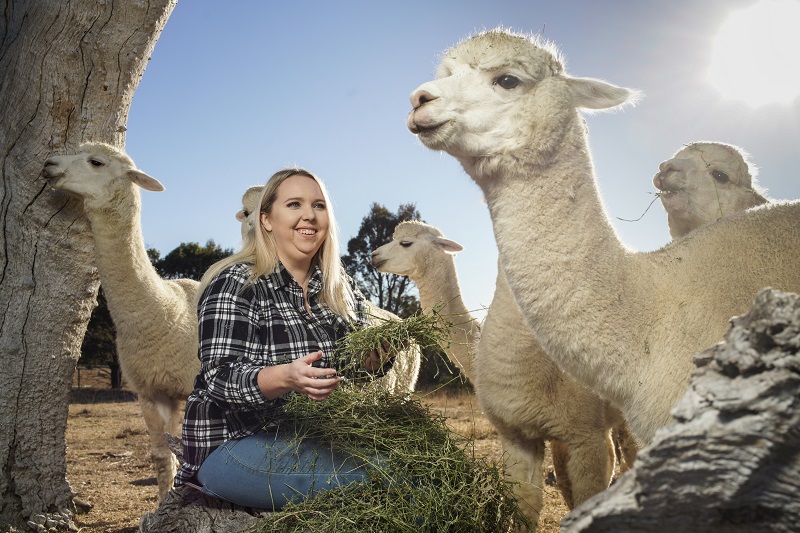In the ongoing war against wild dogs and foxes, alpacas are commonly deployed to the frontline to defend the nation’s sheep flocks. But, astoundingly, it’s a strategy that has never been scientifically tested or proven to be effective – until now.
University of New England (UNE) PhD student Paige Matthews is conducting a comprehensive study of how Australian sheep producers use alpacas as guardian animals, including a world-first survey.
“Alpacas have become a popular form of wild dog and fox deterrent, not just in Australia but elsewhere, so I was quite shocked to discover that no-one had considered how they are being used and how successfully,” said the UNE Environmental and Rural Science student.
“I’m keen to find out how many alpacas are run per sheep, whether producers introduce male or female alpacas and of what age to their flocks, and to gain an understanding of how effective the alpacas are at reducing sheep losses, especially at lambing times.”
Alpacas have been adopted as guardian animals largely on the back of the protective reputation of their wild predecessor, the vicuna of South America, which is known to act aggressively toward canids. In Australia, alpacas are commonly considered an affordable and manageable means of protecting ewes and their offspring at lambing.
“We don’t know exactly how many are being used and where in Australia, but anecdotally it seems that alpacas are becoming more popular as guardian animals to protect sheep from dogs and foxes,” Paige said. “With a growing number of producers looking to invest in alpacas, we hope to answer some of their questions around how best to use and manage them. I’m also keen to learn how alpacas flock with the ewes they are protecting and look into some of the mechanisms behind guarding, like their use of vocalisations.”
Paige has been tracking two wether alpacas introduced to a mob of 180 ewes at UNE’s own farm and observing how they respond to simulated threats.
“It can take a couple of weeks for alpacas to bond with the ewes, which is something producers need to be aware of,” Paige said. “Analysis of the GPS data will undoubtedly provide some further insights into how the alpacas behave with the sheep they are protecting.”
During an experiment to test the alpacas’ reactions to a dog, Paige witnessed them emitting a high-pitched alarm call, which the ewes responded to. “The alpacas ran away from the threat and the sheep followed them,” Paige said. “The alpacas then walked to the outskirts of the mob and ran in again to bring the sheep into a tighter formation. They didn’t move aggressively towards the threat, but herded the flock away from it. The alpacas had clearly become the leaders of the flock.”
Younger alpacas also seem to be just as attentive as older animals, which suggests their protectiveness is an innate behaviour.
“Many people have recommended the use of wether alpacas as guardian animals, but there is not a lot of research to support this,” Paige said. “In our experiment we found that the females were just as attentive as the males. Alpacas have been known to stay with abandoned lambs, but producers have also reported them running towards a threat, stomping and spitting, and found trampled foxes in their paddocks.”
Paige’s research is being conducted under the supervision of Dr Wendy Brown, Dr Amanda Doughty, Dr Emma Doyle and Dr Jamie Barwick. She is asking sheep producers using alpacas across Australia to respond to her survey within the next six months. Go to https://www.surveymonkey.com/r/guardalpacasurvey


